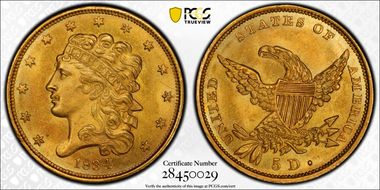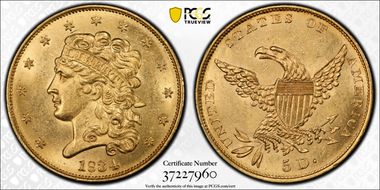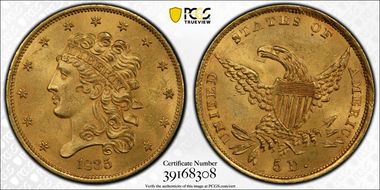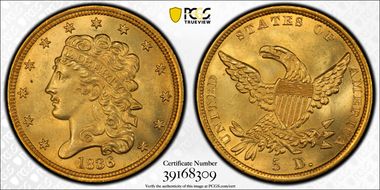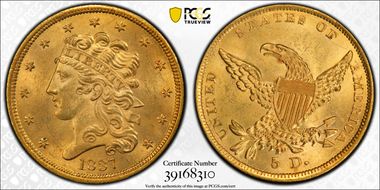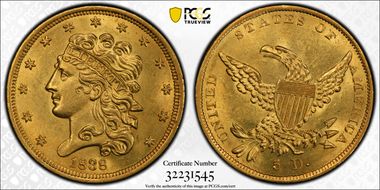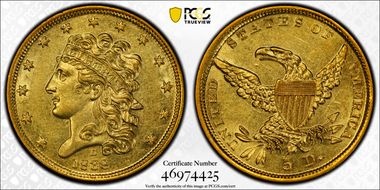Classic Head Half Eagles by die pairing 的展示图片库
HM-1, early die state, R-3. Obverse 1: Script 8, Date with low 8 and 4 and the 34 close; this obverse is unique. Reverse A: Leaf 4 over 3, tongue present. The year 1834 saw the first Classic Half Eagles struck in the United States Mint. Coinage of this type was initially very heavy--amounting to 657,460 pieces. This example is fully lustrous with radiant softly frosted surfaces. Modest hints of a semi-prooflike finish are also discernible in the fields as the coin rotates under a light. Gleaming green-gold color with vivid orange-gold highlights and a sharply executed strike. It is an early die state with no obverse or reverse die cracks evident. Purchased from Crescent City Numismatics; ex: Heritage 1/10: 2176.
CAC, HM-1, early die state, R-3, FAIRMONT. Obverse 1: easily identified by what I think of as "the up and down date". The 1 and 3 are high, 8 and 4 are low; this obverse is unique. Reverse A: Leaf 4 over 3, tongue present. A very crusty, original example with attractive golden-olive color and appreciable luster remaining. Purchased from Doug Winter; ex: Stack’s Bowers 4/2022: 6239 (Fairmont Hoard).
CAC, HM-2, R-4. Obverse 2: Block 8, 4 nearly touches Liberty’s lower curl; this obverse is unique. Reverse B: 5 left of arrow, middle arrow shaft missing left of the eagle’s claw. This example is russet colored with burnt-orange gold toning near the periphery. There is “dirt” in many of the design elements; the eye appeal is very strong for an AU example of this date. Like most examples of this variety, it has a die crack evident between stars six and seven. Purchased on eBay (as an NGC AU55).
CAC, HM-3, late die state, R-2. Obverse 3: Script 8, the 3 and 4 are distant in the date. Reverse C: 5 below D in “5D”, sagging leaf 3 over 4 and no tongue. This coin has deep orange tones which adhere to the margins, while the centers are lighter yellow gold with semi reflective fields. The devices are almost fully struck, except for stars 3 and 4. Contact marks are minor. It has a die crack on the obverse from the eye to the back of the mouth. The reverse has a crack from the left wing tip to the rim and between the lower tips of the second and third arrow heads. Purchased from GreatCollections.
CAC, HM-4, R-5+. Obverse 3: Script 8, the 3 and 4 are distant in the date (same as HM-3). Reverse B: 5 left of arrow, middle arrow shaft missing left of the eagle’s claw (same as HM-2). This is the finest known HM-4, the rarest die pairing in 1834. It is over four times scarcer than the Crosslet 4. On this example, the strike is extremely strong, showing only minor weakness on stars three through five and the BE in the Liberty Band. The luster is frosty, displaying a full cartwheel effect. Brilliant orange and bluish toning are highlighted throughout. The obverse has a die crack running from the eye to the back of the mouth and the reverse has a die crack running along the lower portion of NITED in UNITED. A stunning example of a Classic Head Half Eagle. Purchased from Crescent City Numismatics.
CAC, HM-5, R-2. Obverse 4: Block 8, the 4 in the date is triple punched; noticeable on the upper right of the digit. Reverse A is the same die as HM-1. This is the most common die pairing in the Classic Head Half Eagle series. The coin has swirling, effusive luster on soft orange gold surfaces. The strike is generally strong but consistent with the variety, the hair below the liberty band is very soft. This example is apparently from the first die marriage of the die pair as described in Daryl Haynor’s book. On the reverse, only the die crack between the right wing tip and the rim are present. Purchased from Crescent City Numismatics.
HM-6, “early” die state, R-5. Obverse 4 is the same die as HM-5. Reverse B is the same die as HM-2 and HM-4. This is a rare die pairing with fewer than 80 survivors. This example has a strong strike except for the centers where the hair below the liberty band is weak on the obverse and the junction of the left wing and shield are weak. There are full radial lines on all stars. The color is a consistent green-gold, the luster is plentiful and the ticks/hit minimal for the grade. Like all HM-6, there is a die crack that runs from the rim to the left of N through the bottom of the remaining letters in UNITED. The crack continues very faintly to the right of D but does not approach the rim to the right. In later die states, this crack becomes much heavier and ultimately leads to the demise of the reverse die. Purchased from AURUM Trading.
HM-6, “later” die state, R-5. Obverse 4 is the same die as HM-5. Reverse B is the same die as HM-2 and HM-4. This is a rare die pairing with fewer than 80 survivors. This is a crusty, green gold example with a wonderful visual impression. It is a typical HM-6 with a reverse die crack that runs along the base of all letters in UNITED except for the U, connecting with the rim above N and to the right of D. Purchased from GreatCollections (as an NGC AU55).
HM-8, R-4+. Obverse 3 is the same die as HM-3 and HM-4. Reverse A is the same die as HM-1 and HM-5. This is a scarce variety with only about 110 remaining examples. Very lustrous for the grade with a reasonably strong strike. The underlying color is green gold. The obverse has a die crack within and below the eye which gives the impression of a “tear” and another die crack from the bottom of the hair between the 4 and star 13 to the rim. The reverse has a die crack from the right wing tip to the rim. Stack’s Bowers 3/23: 7015.
CAC, HM-8, “late die state”, R-4+, McCLOSKEY. This is a very original green-gold example with light orange toning. The strike shows weakness on the central devices, particularly on the obverse. The obverse "scarface" die crack runs vertically through Liberty's eye and upper cheek (this is hard to see in the TrueView photos). A second die crack is quite visible at 5:00 from the rim to Liberty's hair; this crack forms a Y in the lower hair curl and traverses upward through the hair. A third die crack connects the 2:00 arm of star 10 with the rim. A fourth crack connects the lowest curl above the hair band with the top ribbon. This was the last use of obverse 3. The reverse has a die crack from the eagle’s right wingtip to the rime. Purchased from Doug Winter, ex: Heritage 1/22:4373 (The McCloskey Collection) where it was sold as an NGC XF45 CAC.
CAC, HM-9, R-4. Obverse 5: Script 8 and the well-known Crosslet 4 in the date; this obverse is unique. Reverse D: There is no tongue, no berry and the 5 is directly below the arrow feather. This example is the first of only two UNC coins verified by CAC for this variety. It has beautiful, original “skin” and is highly reflective with satiny, semi-prooflike luster. The strike is extremely strong for the type; the color is yellow gold. Reverse D exhibits a distinct die clash within the vertical shield stripes. It is the ERT and part of Y from the obverse of 1835 HM-1. 1835 HM-1 was minted prior to the 1834 Crosslet 4. Purchased from Crescent City Numismatics; ex: Bowers and Ruddy 10/77 (Fairfield Collection): 1770.
CAC, HM-1, R-2+. Obverse 1: Block 8 and small 1 in date, the B leans right and the E leans left in Liberty. Reverse D is the same die as 1834 HM-9 (The Crosslet 4). This sharply struck second-year Classic five is honey gold with subtle red gold toning throughout. Impressive cartwheel luster fills the motifs and borders. Like many examples of this die pairing, there are obverse clash marks in the hair and Liberty band and reverse clash marks within the shield. Heritage 1/19: 5667; ex: Heritage 1/13:7104.
CAC, HM-2, R-3. Obverse 1 is the same die as HM-1. Reverse C is the same die as HM-3 and HM-7 in 1834. This is another sharply struck Half Eagle. The color is green-gold with attractive orange-gold highlights (the color is lighter than the PCGS image). Frosty luster is prevalent on both the obverse and reverse surfaces. Like all examples of this die pairing, the obverse has clash marks in Liberty’s band, hair and ear. The reverse has three distinct die cracks – from the left and right wing tips to the rim, and between the lower tips of the second and third arrowhead. Purchased from Heritage (as an NGC AU58).
HM-3, R-5+. Obverse 1 is the same die as HM-1 and HM-2. Reverse E: Leaves 1 and 2 are near the U in UNITED. HM-3 is rare with approximately 35 suspected survivors; this is perhaps the finest known example of this variety. Exceptionally vivid reddish-gold surfaces are also intensely lustrous in a predominantly frosty texture. Direct lighting calls forth subtle semi-reflective qualities from the fields. Razor sharp striking detail further enhances the appeal of this example. Like all examples of this die pairing, the obverse has clash marks in Liberty’s band, hair, and ear. Stack’s Bowers 3/20: 4182.
HM-4, R-6. Obverse 1 is the same die as HM-1, HM-2 and HM-3. Reverse A is the same die as HM-1, HM-5, and HM-8 in 1834. This die pair of the 1835 Half Eagle is very rare with only 20 suspected survivors. The surfaces are green-gold with subtle rose-gold toning. Well struck with frosty luster. Like all examples of this die pairing, the obverse has clash marks in Liberty’s band, hair, and ear. The reverse demonstrates die deterioration in the ED of UNITED and a die crack between the right wing and the rim. Purchased from Doug Winter.
CAC, HM-5, R-6+/7. Obverse 2: Tall 1 and block 8 in the date. Reverse E is the same die as HM-3. This pairing of 1835 Half Eagle trails only the 1836 HM-9 in rarity among Classic Head Half Eagles. There are fifteen or fewer suspected survivors including both circulation strike and proof examples. This example has very “clean” even surfaces. The color is orange-gold with some residual luster, particularly at the periphery. If coins had nicknames, this one would be Serendipity. I generally don’t look for coins on eBay, preferring to buy from known dealers. When I couldn’t find anything for a while, I decided to look and there it was. Because of the CAC sticker it was priced like a XF45 but of course I snapped it up. Purchased on eBay.
CAC, HM-6, late die state, R-6. Obverse 2 is the same die as HM-5. Reverse A is the same die as HM-4 in 1835 and HM-1, HM-5, and HM-8 in 1834. This is another very rare pairing with only 20 suspected survivors. This is the finest known example of this pair. A strong strike and vibrant luster highlight the yellow gold colors of this coin. It represents the terminal die state for obverse 2; it has a distinct die crack that dissects stars 5 and 6, runs through Liberty’s band and then dissects stars 12 and 13. The reverse demonstrates that it is the “remarriage” of 1835 obverse die 2 and reverse A. On the reverse, there are die cracks from both wing tips to the rim, deterioration of ED and a die bulge in the right notch of the N in UNITED. Purchased from ONR Coins.
HM-7, R-6. Obverse 3: This is the only Script 8 obverse in 1835. Reverse F: There is a berry and the D in 5D is repunched. This is the only reverse in 1835 with a berry. Yet another very rare 1835 variety with only 20 expected survivors. This coin has a great deal of frosty luster in the recessed areas and less wear than normally seen on an XF45. The color is much lighter than depicted on the TrueView image. The reverse has a die crack starting below Leaf 4 and running through the eagle’s left side and neck almost to the E in STATES. Purchased from Doug Winter.
CAC, HM-8, R-3+. Obverse 3 is the same die as HM-7. Reverse A is the same die as HM-4 and HM-6 in 1835 and HM-1, HM-5, and HM-8 in 1834. Tied for finest known at PCGS (13 MS64) and CAC (3 MS64). This is the third most common 1835 die pairing but there are still only 200 suspected survivors. Two of the MS64 1835 half eagles were stuck from these dies; the current coin and the Pogue-Haynor example which sold in September 2022. This well stuck example is green gold with pleasing cartwheel luster. Though well struck, the reverse die is now showing a great deal of deterioration. There are many die cracks, noticeable along the bottom of many letters and from the wing tips to the rim. The right side of the N in UNITED and the top of the first S in STATES are filled in. Purchased from Crescent City Numismatics.
CAC, HM-1, early die state, R-6. Obverse 1: Single forelock curl, straight nose, large 6 tilts left close to curl. Reverse F is the same die as HM-7 in 1835. It is the second rarest die pairing in 1836 with only 20 expected survivors. This coin is green gold with slight orange toning toward the periphery. The strike is good, and the coin is very pleasing for an XF40. This example does not have the obverse die crack between stars 5 and 6 that is a normal characteristic of this obverse die or the reverse die crack that frequently exists vertically through the E in States. Purchased from Crescent City Numismatics (as an NGC XF45).
HM-1, “normal die state”, R-6. Obverse 1: Single forelock curl, straight nose, large 6 tilts left close to curl. Reverse F is the same die as HM-7 in 1835. This coin is yellow-green gold with a good deal of residual luster around the peripheral devices. This example has an obverse die crack between stars 5 and 6 that is characteristic for this variety. It also has a faint reverse die crack through the E in STATES to the eagle’s head behind the eye. Heritage 1/20: 7830 (as an NGC AU55).
HM-2, R-4+, BASS-HAYNOR. Obverse 2: Double forelock, rim to rim die crack from Star 8 through 6 in the date. Reverse F is the same as HM-1 in 1836 and HM-7 in 1835. This is a very scarce 1836 pairing with only 100 suspected survivors. Reddish-rose toning appears to drift toward the borders on both sides of this otherwise honey-olive example. The luster is prevalent in the recesses; the strike is somewhat soft, particularly on the central obverse devices. The obverse rim to rim die crack on this example is very shallow and runs from the left part of star eight through the T down through the 6. The reverse rim to rim die crack is more pronounced and runs through the E through the eagle’s head, the right wing’s attachment to the shield then right of leaf four. Purchased from Doug Winter, ex: Ex Stack’s Bowers 8/22: 5043 (The Virginian Collection – Daryl Haynor); SB /21: 2481 (Harry Bass)
CAC, HM-2, R-4+, FAIRMONT. Pleasing honey-gold surfaces exhibit tinges of pale olive as the coin rotates under a light. Boldly defined overall with appreciable luster remaining. As with most examples of this variety, there are vertical die cracks on both the obverse and reverse. Stack’s Bowers 8/20: 1335, The Fairmont Collection.
CAC, HM-3, R-4. Obverse 2 is the same die as HM-2. Reverse A is the same die as HM-4, HM6 and HM-8 in 1835 and HM-1, HM-5, and HM-8 in 1834. This coin is 100% original with great green-gold color and just the slightest hint of wear. The frosty luster is abundant, and the strike is strong for the die pairing. As with all known examples of this pairing, there is a bold vertical die crack running from star 8 through 6 in the date on the obverse. Purchased from Doug Winter.
CAC, HM-4, R-3+. Obverse 3: Single forelock curl, curved nose, tall 1 and low 8 in the date; this obverse is unique. Reverse G: Two long dentils above the O in OF, wide 5 D. This example has a rich golden luster that has a radiant flash on both sides. Sharply struck devices are fully frosted and show crisp, complete definition. Legend Auctions 3/20:399; ex: DLRC 7/13; Stacks’s Bowers 2/13:2162.
CAC, HM-5, early die state, R-5. Obverse 4: Double forelock with large top curl, tall 1 below 8, L in LIBERTY is high and tilted left; this obverse is unique. This is one of three rare varieties in 1836 with only 70 suspected survivors. This example is an ‘old soldier’ with dirt in the recessed areas. It is honey gold with orange gold highlights. It has the characteristic extreme flatness of the stars and coppery-orange toning. Unlike many (most?) examples of this obverse, there are no die cracks present. Stack’s Bowers 3/20: 23439.
HM-5, “normal die state”, R-5. Obverse 4: Double forelock with large top curl, tall 1 below 8, L in LIBERTY is high and tilted left; this obverse is unique. Reverse H: Small berry with no stem, 5 directly under the feather; this reverse is unique. It is the orange-gold color that this die pair is known for, with a strong strike of the central devices. The luster is outstanding for the grade. This obverse has the characteristic extreme flatness of the stars as well as the die crack that extends upward and nearly vertically between the 8 and 3 up to Liberty’s hair below the Liberty Band. Heritage 9/20: 21676.
HM-6, R-3, POGUE. Obverse 5: Double forelock, Tall 1 and high, R in LIBERTY is high. Reverse I: Berry with stem, very wide 5 D, O larger than F. A substantial mintage of 553,147 Classic Head half eagles was produced in 1836, with nine different die varieties known for the date. Smooth satiny luster evenly coats both sides, each a light apricot gold. Devices on obverse and reverse are nicely struck, lending further appeal to the supremely attractive and very frosty surfaces. Purchased from Heritage; ex: Stack’s Bowers 5/16: 4053 (Pogue Collection).
CAC HM-6, R-3. A very nice collector grade example with especially pleasing deep reddish color at the reverse border. Although common by Classic Head Gold standards, CAC examples of this die pairing are rare. Purchased from Doug Winter.
CAC/OGH, HM-7, R-3. Obverse 5 is the same die as HM-6. Reverse G is the same die as HM-4. This is the most common 1836 die marriage. The swirling cartwheel luster is exceptional. This orange-gold example has a strong strike except for weakness in stars five and six, a characteristic for this die pairing. GreatCollections 10/20: 885891.
HM-8, R-4. Obverse 6: Double forelock, short 1 and high 6 in date, star 13 close to dentils. Reverse I is the same die as HM-6. This is another scarce variety with only 190 suspected survivors. Clean surfaces are the highlight of this green-gold coin. A good deal of luster surrounds many of the peripheral devices. Heritage 4/20: 7730 (as an NGC AU55).
CAC, HM-8, “later die state”, R-4. Doug Winter describes this coin as “A Gem for the grade with rich totally natural reddish and orange-gold color’. The strike is soft on the obverse central devices. There is a die crack from the right wingtip to the rim. Purchased from Doug Winter.
CAC, HM-9, R-7, Haynor. Obverse 7: Script 8, the only 1836 Half Eagle with this style; this obverse is unique. Reverse J: Floating serif of an extra letter to the left of U in UNITED; this reverse is unique. This is the rarest die pairing in the Classic Head Half Eagle series; probably fewer than 10 examples have survived. It is easily identified because it is the only Script 8 in 1836. Warmly and evenly patinated in honey-gold, light olive highlights mingle nicely over both sides. The surfaces are moderately abraded. Stack’s Bowers 8/22: 5050 (Daryl Haynor’s The Virginian Collection); ex Heritage 10/2014: 4998 (as an NGC XF40 CAC).
HM-1, R-4. Obverse 1: Block 8, Double forelock; this obverse is unique. Reverse K: Shaft of 2nd arrowhead intact, small berry with stem detached from branch; this reverse is unique. This die pairing is the scarcest of the 1837s. This example is exceptionally lustrous with a strong cartwheel effect. The strike is very strong except for slight weakness in the hair below liberty. In his manuscript, Daryl Haynor describes a somewhat unique color for this variety; lemon-gold or mustard-gold. This example is the best example of mustard-gold I have seen in this series. Purchased from Heritage.
CAC, HM-1, R-4. This die pairing is the scarcest of the 1837s. This example has a weak strike (or die damage) at the centers, with the E in LIBERTY particularly weak. It has honey gold color and flashy cartwheel luster. Purchased from Silicon Valley Coins.
CAC, HM-2, R-3+. Obverse 2: The only obverse of the issue with both a single forelock curl and block 8 in the date: this obverse is unique. Reverse L: The middle arrow shaft is broken within the eagle's talon, the only reverse of the issue with this feature. Reverse L is the same as 1838 HM-1. 1837 had the lowest P-mint mintage in the Classic Head Half Eagle series; the HM-2 die pairing is the most common of the three pairings that year. On this example the striking details are complete throughout. The mint luster is abundant and shows a bright, frosted sheen on orange gold surfaces. There are a few insignificant luster grazes on the obverse and a light alloy spot below the eagle's beak on the reverse. Purchased from Crescent City Numismatics.
CAC, HM-3, R-4. Obverse 3: Script 8, Single forelock curl, Small Date with arch on the 7; this obverse is unique. Reverse M: There is no berry; this reverse is unique. The HM-3 die pairing is scarce for this date with only 150 suspected survivors. This is a lovely coin for the grade with a great strike and even natural yellow and green gold coloration. The luster is frosty. Purchased from Doug Winter.
CAC, HM-1, R-3. Obverse 1: Tall curved serif on 1, center dot in ear; this obverse is unique. Reverse L is the same die as HM-2 in 1837. Beaming, satiny mint luster blooms with a vivid brilliance on both sides. Boldly struck up on the obverse and reverse, the details are crisp and show impressive frost on the devices. There is a clash mark on the reverse in the eagle’s mouth and below the beak. Legend Auctions 10/20: 378.
CAC, HM-2, R-3. Obverse 2: Shallow serif on 1, no center dot; this obverse is unique. Reverse N: TES in STATES is wide and the middle arrow shaft is not broken; this reverse is unique. On this example, lovely surfaces offer a bold strike, minimally abraded surfaces, ample luster and rich rose gold color throughout. This is a later die state with Star 1 weakness, showing no radial lines. Purchased from Crescent City Numismatics, ex: Legend Auctions 10/15: 324; Heritage 4/13: 5748.
HM-1, late die state, R-4+, Haynor. Obverse 1: There is only one obverse die for the ’38-C. Reverse P: Leaves 1 and 2 are far from the U in UNITED; this reverse is unique. The underlying color is green-gold but there is some reddish-russet build up within the protected areas of Liberty's portrait, as well as in isolated peripheral areas on both sides. This is a late die state example of the HM-1 die pairing where extensive die lapping has removed the berry and the connection between the stems of the leaves and the eagle’s leg. Stack’s Bowers 8/2022: 5054 (Daryl Haynor’s The Virginian Collection); ex: Heritage 1/08: 3162.
CAC, HM-2, early die state, R-7. Obverse 1: There is only one obverse die for the ’38-C. Reverse Q: Leaf 2 touches the U in UNITED; this reverse is unique. The 1838-C is the rarest date/mint combination in the Classic Head Half Eagle series and this pairing is the rarer of two distinct pairings. This example is very original with green-gold color and rich orange highlights. The strike shows much sharper detail than normal for this mint. It was minted before the die crack which normally bisects the reverse of this pairing. There are only three or four known examples in this state. This is a truly exceptional example of this very rare type. Purchased from Doug Winter.
CAC/OGH, HM-2, late die state, R-5. This example is a “crusty old soldier” which exhibits great olive gold color with orange highlights. It has original dirt in the recessed areas, a lovely example of this date. It has the characteristic die crack which bisects the reverse from 2 o’clock to 8 o’clock. Purchased from Crescent City Numismatics.
HM -1, R-3. Obverse 1, Reverse R: There is only one die pair known for the 1838-D half eagle; both the obverse and reverse are unique dies. The most recent estimate is that only 10-12 examples are known in mint state. The strike on this yellow gold example is exceptional; the only weakness is on the peripheral stars where the radial lines are generally missing; this probably resulted from excessive die polishing. The texture is a subtle frost with prooflike characteristics, particularly on the reverse. There is some die rust evident with raised “bumps” in front of the top of the throat.
CAC, HM-1, R-3. Obverse 1, Reverse R: There is only one die pair known for the 1838-D half eagle; both the obverse and reverse are unique dies. The most recent estimate is that only 55 examples are known in AU. The colors are a blend of deep orange-gold and lighter pinkish-rose colors. The satin luster is brightest in the protected areas around and among the design elements. The design elements are well struck in general and mostly sharp, mentionable softness being confined to the stars around the obverse periphery. Stack’s Bowers 8/23: 4056; ex Stack’s Bowers 8/22: 6078 (the John O. Sykes Collection).
























